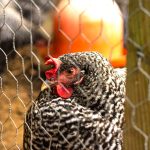Foxes are intelligent and adaptable predators that present a significant risk to chicken coops. These primarily nocturnal animals are most active at night when chickens are roosting and vulnerable. Foxes possess excellent digging and climbing abilities, enabling them to access inadequately secured coops.
Their acute sense of smell allows them to detect chickens from afar, making them persistent in their pursuit. Foxes are opportunistic hunters known for their patience and persistence. They often observe potential targets from a distance before taking action.
Using their agility and stealth, foxes can gain access to coops by digging under fences or climbing over obstacles. Their determination and resourcefulness make it essential for poultry owners to implement robust protective measures. Understanding fox behavior is crucial for developing effective strategies to safeguard chickens.
By recognizing the habits and capabilities of these predators, poultry owners can implement targeted security measures to protect their flocks and deter fox attacks.
Table of Contents
- 1 Creating a secure coop: Building a fox-proof chicken enclosure
- 2 Natural deterrents: Using plants and scents to repel foxes
- 3 DIY fox deterrents: Homemade solutions to keep foxes away
- 4 Electric fencing: Setting up a barrier to keep foxes out
- 5 Monitoring and maintenance: Regular checks to ensure fox-proofing is effective
- 6 Seeking professional help: When DIY methods are not enough
- 7 FAQs
- 7.1 What are some effective DIY methods to keep foxes away from chickens?
- 7.2 How can I secure my chicken coop to prevent foxes from getting in?
- 7.3 Are there any natural deterrents that can help keep foxes away from chickens?
- 7.4 What should I do if I spot a fox near my chicken coop?
- 7.5 Are there any non-lethal methods to deter foxes from preying on chickens?
Key Takeaways
- Foxes are intelligent and adaptable predators, known for their digging and climbing abilities
- A secure coop should have a sturdy fence buried at least 12 inches underground and a roof to prevent foxes from digging or jumping in
- Certain plants like lavender and marigold, as well as scents like citrus and vinegar, can help deter foxes from entering your property
- DIY fox deterrents include motion-activated sprinklers, noise-making devices, and natural repellent sprays
- Electric fencing can be an effective barrier to keep foxes out, but it requires regular maintenance and monitoring to ensure it remains functional
- Regular checks of the coop and surrounding area are essential to identify and address any potential weak points in the fox-proofing measures
- If DIY methods are not effective, seeking professional help from wildlife experts or pest control services may be necessary
Creating a secure coop: Building a fox-proof chicken enclosure
Materials and Design
When constructing a secure coop, it is essential to use sturdy materials such as wire mesh or hardware cloth to prevent foxes from gaining access. The mesh should be buried at least 12 inches into the ground to prevent foxes from digging underneath it. Additionally, the coop should have a secure roof to prevent foxes from climbing over the top and accessing the chickens. The design of the enclosure should also include features such as locks and latches to ensure that foxes cannot easily open doors or gates.
Barriers and Fencing
The placement of barriers is crucial in creating a fox-proof chicken enclosure. Fences should be tall enough to prevent foxes from jumping over them, typically at least 6 feet high. It is also important to consider adding an apron or skirt to the bottom of the fence, extending outward to further deter digging.
Maintenance and Inspection
Poultry owners should regularly inspect the coop for any potential weak points or vulnerabilities that could be exploited by foxes. By taking these measures, poultry owners can create a secure coop that effectively protects chickens from the threat of foxes.
Natural deterrents: Using plants and scents to repel foxes

In addition to physical barriers, natural deterrents can be used to repel foxes and protect chicken coops. Certain plants and scents are known to be effective in deterring foxes from entering an area, making them valuable tools for poultry owners. One example of a natural deterrent is the use of strong-smelling plants such as lavender, mint, or rosemary around the perimeter of the coop.
These plants emit odors that are unpleasant to foxes, discouraging them from approaching the area. Poultry owners can also use natural scents such as citrus peels or vinegar to create barriers that deter foxes from accessing the coop. Another natural deterrent that can be used to repel foxes is the presence of larger predators such as dogs or coyotes.
The scent of these animals can signal danger to foxes, causing them to avoid areas where these predators are present. Poultry owners can strategically place items such as dog hair or urine around the perimeter of the coop to create the illusion of a larger predator presence. By using natural deterrents such as plants and scents, poultry owners can effectively repel foxes and protect their chicken coops from potential harm.
DIY fox deterrents: Homemade solutions to keep foxes away
There are several do-it-yourself (DIY) fox deterrents that poultry owners can use to keep foxes away from their chicken coops. One effective homemade solution is the use of motion-activated sprinklers, which can startle and deter foxes from approaching the coop. These sprinklers can be strategically placed around the perimeter of the coop and activated by motion sensors, creating a sudden burst of water that scares off potential predators.
Poultry owners can also use homemade repellent sprays made from natural ingredients such as chili peppers or garlic, which emit strong odors that are unpleasant to foxes. Another DIY fox deterrent is the use of noise-making devices such as wind chimes or bells, which can startle and deter foxes from approaching the coop. These devices can be hung around the perimeter of the coop and activated by wind or movement, creating unexpected sounds that discourage foxes from entering the area.
Poultry owners can also consider using reflective materials such as aluminum foil or CDs to create visual deterrents that deter foxes from approaching the coop. By using these homemade solutions, poultry owners can effectively keep foxes away from their chicken coops and protect their poultry from potential harm.
Electric fencing: Setting up a barrier to keep foxes out
Electric fencing is an effective barrier that can be used to keep foxes out of chicken coops. This type of fencing delivers a mild electric shock when touched, creating a strong deterrent for potential predators such as foxes. Electric fencing should be installed around the perimeter of the coop at a height of at least 6 feet to prevent foxes from jumping over it.
Additionally, it is important to bury the bottom of the fence at least 12 inches into the ground to prevent foxes from digging underneath it. Poultry owners should also regularly inspect and maintain electric fencing to ensure that it remains effective in deterring foxes. When setting up electric fencing, it is important for poultry owners to follow safety guidelines and regulations to prevent harm to both animals and humans.
Proper signage should be displayed around the perimeter of the fence to alert individuals to its presence, reducing the risk of accidental contact. Poultry owners should also regularly test the voltage of the fence and ensure that it is functioning properly to effectively deter foxes. By setting up electric fencing around chicken coops, poultry owners can create a strong barrier that effectively keeps foxes out and protects their poultry from potential harm.
Monitoring and maintenance: Regular checks to ensure fox-proofing is effective

Inspecting the Coop’s Perimeter
Poultry owners should regularly inspect the perimeter of the coop for any signs of damage or weakness that could be exploited by foxes. This includes checking for holes in fences, loose mesh or wire, or areas where foxes may have attempted to dig underneath barriers.
Maintaining Effective Deterrents
Any vulnerabilities should be promptly addressed and repaired to maintain the integrity of the coop’s defenses against foxes. In addition to regular checks of physical barriers, poultry owners should also monitor the effectiveness of natural deterrents and DIY solutions in repelling foxes. This includes assessing whether plants and scents remain effective in deterring foxes, as well as ensuring that motion-activated sprinklers or noise-making devices continue to function properly.
Testing Electric Fencing
Poultry owners should also regularly test electric fencing to ensure that it delivers a strong deterrent for potential predators such as foxes. By conducting regular monitoring and maintenance, poultry owners can ensure that their fox-proofing measures remain effective in protecting their chicken coops from harm.
Seeking professional help: When DIY methods are not enough
In some cases, DIY methods may not be enough to effectively protect chicken coops from the threat of foxes, prompting poultry owners to seek professional help. Professional assistance may be necessary when dealing with persistent or particularly cunning foxes that continue to find ways to access a coop despite DIY deterrents. Wildlife experts or pest control professionals can provide valuable insight and expertise in developing targeted strategies to deter foxes and protect poultry from harm.
Professional help may also be necessary when dealing with larger-scale infestations or threats posed by multiple predators such as foxes. In these cases, wildlife experts can assess the situation and recommend more comprehensive solutions such as trapping and relocating problem animals or implementing advanced deterrent measures. By seeking professional help, poultry owners can access specialized knowledge and resources that can effectively address the threat of foxes and protect their chicken coops from potential harm.
If you’re looking for ways to keep foxes away from your chickens, you may also be interested in learning about the best chicken coops to protect your flock. Check out this article on Farmhouse Chicken Coop and Producers Pride Sentinel Chicken Coop for tips on creating a secure and safe environment for your chickens.
FAQs
What are some effective DIY methods to keep foxes away from chickens?
Some effective DIY methods to keep foxes away from chickens include installing a sturdy fence with an overhang, using motion-activated lights or sprinklers, and using strong-smelling deterrents such as garlic or predator urine.
How can I secure my chicken coop to prevent foxes from getting in?
To secure your chicken coop and prevent foxes from getting in, you can use hardware cloth to cover all openings, reinforce the coop with sturdy materials, and install locks or latches that are fox-proof.
Are there any natural deterrents that can help keep foxes away from chickens?
Yes, there are natural deterrents that can help keep foxes away from chickens. Some examples include planting thorny bushes or using strong-smelling herbs and spices around the coop.
What should I do if I spot a fox near my chicken coop?
If you spot a fox near your chicken coop, it’s important to act quickly to scare it away. You can make loud noises, use a flashlight, or even use a water hose to deter the fox from coming near the coop.
Are there any non-lethal methods to deter foxes from preying on chickens?
Yes, there are non-lethal methods to deter foxes from preying on chickens. These include using visual deterrents such as scarecrows or reflective tape, as well as using sound deterrents such as wind chimes or radios.
Meet Walter, the feathered-friend fanatic of Florida! Nestled in the sunshine state, Walter struts through life with his feathered companions, clucking his way to happiness. With a coop that’s fancier than a five-star hotel, he’s the Don Juan of the chicken world. When he’s not teaching his hens to do the cha-cha, you’ll find him in a heated debate with his prized rooster, Sir Clucks-a-Lot. Walter’s poultry passion is no yolk; he’s the sunny-side-up guy you never knew you needed in your flock of friends!







